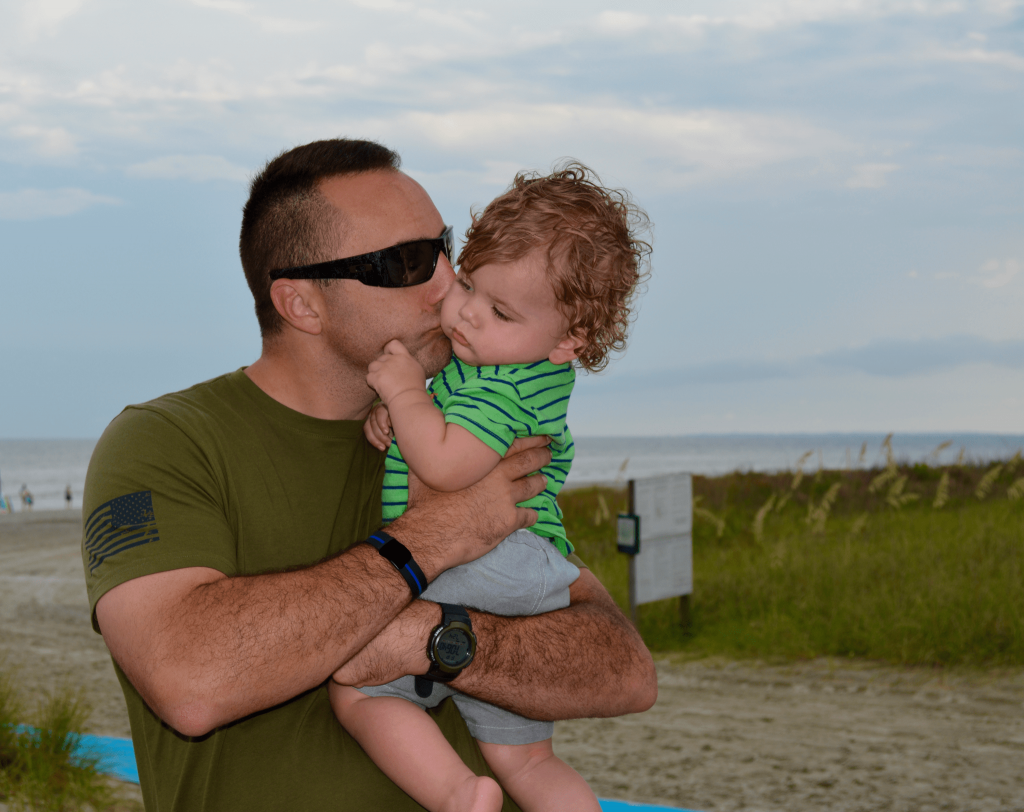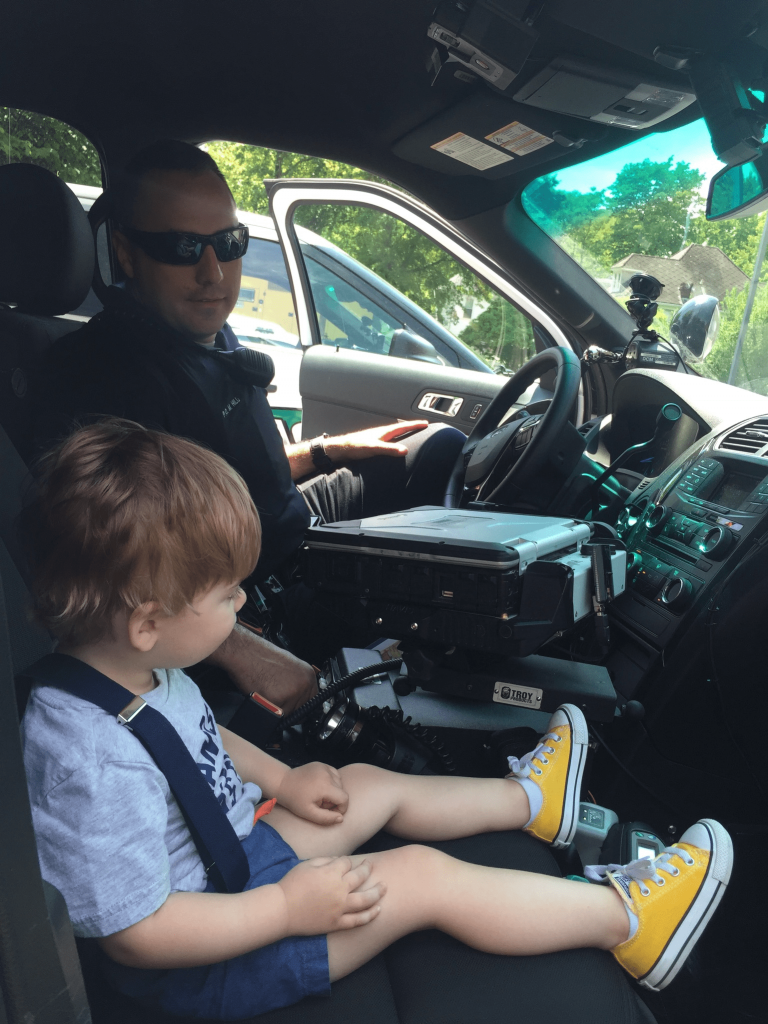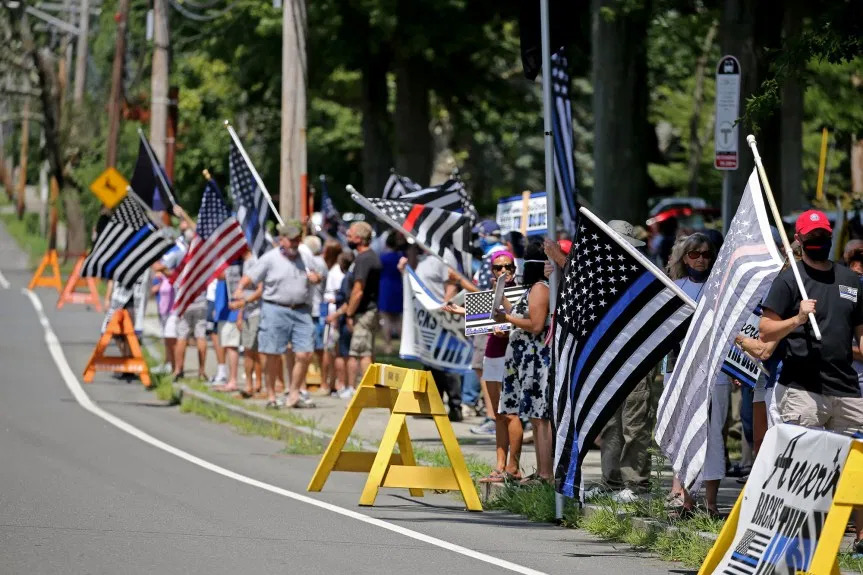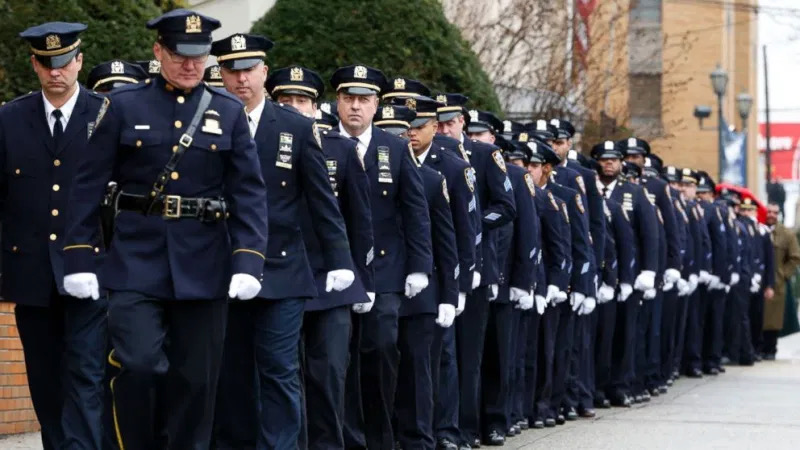“The Thin Blue Line.”
By Matt Hill
You see it everywhere these days. From minivans bumpers to a flag flying in a front yard, to shirts, hats, license plates, and even tattoos. There are people that use the Thin Blue Line as a backdrop to the mantra “Blue Lives Matter.” And recently, you may have even seen members of some alleged hate groups fly the flag as an “anti-Black Lives Matter” symbol. But what does the Thin Blue Line actually signify? Why is it so meaningful to a section of society? And, since an alleged racist organization used it in a rally should it now be deemed a racist symbol and banned from society?
As a police officer for the better part of the last decade, I stood as a small part of that Thin Blue Line (TBL). In some of my assignments, I was the sole Thin Blue Line present when incidents occurred. Once, I was seriously injured while performing my duties as a part of that line. At times, I felt the sheer weight of the symbology on my back and in others, I felt a true brotherhood.
But, what led to this simple black space with a blue line in the center being a “thing” anyway? Let’s take a quick peek into the origins of the TBL.
According to the Marshall Project, a nonprofit publication about Criminal Justice, the origins of the term “Thin Blue Line” are seen as far back as 1854 and it referred partially to a British battle formation. However, the term first became mainstream among police officers in New York City in 1922.
In the 1950s, there was a television show with the phrase as its title. The term was consistently used by politicians in speeches; it was used in the press, and in multiple novels of that era. Since then, the term has been used the world over by officers or people who wish to show them support. In 2016, then-presidential candidate Donald Trump was quoted as saying that police are, “The force between civilization and total chaos.” Hence, the Thin Blue Line.
Dallas Police Sergeant Stephen Bishopp holds a doctoral degree and has studied police stress, use of force, and officer misconduct. He asserts that the term symbolizes respect and understanding for families who have lost an officer in the line of duty. Bishopp said, “When I see that flag as a sticker on a car or flying in someone’s yard, I know that there is someone there that knows what I’m going through.”
But what does the symbol mean to an officer, a man or woman who is part of the line? Does it truly create an “us vs. them” mentality as I’ve heard some attempt to articulate or does it mean something different altogether?
In this article, I will describe what the Thin Blue Line means to me and what it means to some of my personal law enforcement friends whom I spoke to during this article’s writing.
In the movie End of Watch, there is a powerful quote that for me succinctly describes the Thin Blue Line.
“I’m the police, and I’m here to arrest you. You’ve broken the law. I did not write the law. I may even disagree with the law but I will enforce it and no matter how you plead, cajole, beg, or attempt to stir my sympathies, nothing you do will stop me from placing you in a steel cage with gray bars. If you run away, I will chase you. If you fight me, I will fight back. If you shoot at me, I will shoot back. By law I am unable to walk away. I am a consequence. I am the unpaid bill. I am fate with a badge and a gun. Behind my badge is a heart like yours. I bleed, I think, I love, and yes, I can be killed. And although I am but one man, I have thousands of brothers and sisters who are the same as me. They will lay down their lives for me, and I them. We stand watch together, a thin blue line, protecting the prey from the predators, the good from the bad. We are the police.”
I spoke to a number of my friends who are still holding the Thin Blue Line. Here are some things they said about what they see in the Thin Blue Line.
“The Thin Blue Line sees no race. All it sees is a common bond between brothers and sisters to protect the good from the evil.” Another said, “There are sheep in the world and there are wolves. The thin blue line stands in the middle as a sheepdog to protect the sheep from the wolves.”
Yet another stated, “The thin blue line is a banner/flag of ideals this country was built upon. It represents the lives of those charged with domestically protecting American citizens at any cost.”
And one just referred straight back to the opening monologue in the End of Watch which you just read above.

Believe it or not, most peoples’ first comment, when they hear you are a police officer, is, “Well it must be nice to be able to get out of any ticket.” First off, that is simply not true. It certainly holds some merit, but I also know plenty of officers who were given silly tickets that I wouldn’t have written to anyone, cop or not. That said, my response is almost always, “Cops need some kind of perk to deal with the crap we handle every day. The only perk we really get is not getting tickets. It isn’t that big — or that great — of a deal.”
Many people don’t know the real reason why some police officers allow other officers “professional courtesy” and don’t issue them tickets. The real reason is that it can — and has — started a ridiculous back-and-forth between departments which can occasionally cause huge rifts between officers and even entire departments. Because of that, many officers will simply offer professional courtesy to an officer of another jurisdiction. I know, I know. Some of you might think that this is petty and pathetic and shouldn’t be a justification. I may agree, but it’s the truth. To be honest, professional courtesy is often also extended to firefighters, paramedics, nurses, and especially doctors. After all, one of them may be taking care of you if you happen to be on the hot side of a bullet.
In the Thin Blue Line I see solidarity. Not in the mentality of police versus community, but in the sense that when I meet another member of that same line we have a sort of unspoken bond and know that we’ve likely gone through the same training and have very similar experiences.
This, I think, is very similar to those who were in a specialized military unit such as the Army Rangers, Army Green Berets, Navy SEALs, or Marine Raiders. As a member of any of those units, you automatically have a pretty good sense that the person who earned the same title as you has specific capabilities. You know that they will likely be there to stand by your side if, and when, needed.
I spoke to John Black, retired Army Special Forces Green Beret and SOFREP staff writer who said the following about this unique bond:
“I feel that immediate bond or brotherhood upon meeting someone such as another Green Beret, Navy SEAL, etc. Although we have never trained together, fought together, or even met, the sense of brotherly bond is there immediately. Moreover, you can usually spot these people in a crowd of total strangers by the vibe they put off.”
That is exactly how I look at the Thin Blue Line. It’s an unspoken brotherhood shared by those with common experiences. I agree with John Black, too, in that usually, you can pretty easily spot a cop in a crowd if you know what to look for.
This bond could be vaguely akin to fraternity brothers (or sorority sisters), or people in any military branch, certain work unions, or even people with an insanely dangerous job like skyscraper window cleaners. There is a certain bond that forms with unique, often crappy, experiences (like boot camp, the Police Academy, or SF selection). If you’ve never felt that bond in life, you’re truly missing out.
An outsider simply doesn’t understand what those common training pipelines and experiences are, or how they feel — which is much more important. Let me give you just a few examples of crappy experiences from the police world that serve to help us form bonds.

First, if you haven’t done it, staying up for a 12-hour night shift on a cold, rainy December night sucks. As in, it is totally awful. And that’s if you don’t get a ton of calls. If you’ve never responded to a house where a loved one found a family member deceased you wouldn’t quite understand the feeling. If you’ve never given CPR to a husband while his wife screams “SAVE HIM” in your ear you may not get it. If you’ve never driven that same wife to the hospital and stood with her when they pronounced her husband dead, it may be foreign to you. If you’ve never worked a double 12-hour shift because 20 minutes before your shift ended someone decided to kill, rape, or otherwise maim someone else, then you don’t quite know the feeling. If you’ve never tried to arrest someone high on PCP who wanted to fight the passing cars, it’s a mystery to you. Or, if you’ve never had a complaint made on you because you “weren’t friendly to the caller during their call for service for a dead raccoon in the street” even though you had just finished giving CPR to a man who just minutes before had been playing tennis but is now dead and you just aren’t really in the mood to field a stupid call. I’m not saying it is bad that you don’t know how these experiences feel and I’m certainly not saying I’m better or cooler because I do know. I’m just saying you don’t know. And you don’t understand that which you don’t know.
However, if you’re a part of the Thin Blue Line I know you already get it. I know you get it just by seeing that line on your shirt or your car. And if you just have it displayed as a show of support, then at least you want to understand it and you appreciate those who do. It doesn’t matter whether you work for NYPD or for a small sheriff’s department in rural Kentucky: you get it. If you have stood as a part of that line for any amount of time, you have all of those experiences I listed and thousands more.
I also think of those who were lost when that Thin Blue Line was cracked for a time. As an officer, I’ve both responded to “Officer in Need of Aid” calls where the officer was shot, stabbed, or was getting beaten by someone whom they could not control. I’ve also had close friends shot in the line of duty and was an officer when a handful of officers near where I worked were killed in the line of duty. The Thin Blue Line also pays homage to those guys and gals. Those whom we call heroes, but who wouldn’t consider themselves any such thing, if they were still able. The TBL stands in solidarity with the fallen and their families as members of our family, though they were perhaps an otherwise unknown stranger only days prior.

Sometimes, people outside of law enforcement fly a TBL flag showing their support for officers. I think this is great and it really does mean a lot to an officer when he/she drives past a house and sees a sign or a flag with a Thin Blue Line. It is a small token of appreciation that just may help that officer push through another hard shift, or through one more heartbreaking call. Officers love knowing that there are still people out there who support them. So yes, fly the flag with pride. It’s certainly appreciated.
Now, there have been of late been those who have misrepresented the Thin Blue Line or used it for their own forms of hate speech. It’s disgusting. It’s unacceptable to the members of the TBL and I for one reject their ideology. They’ve used the symbol as a symbol of hatred and people have seen the negative press. So, should we just rid the nation of the TBL because one group of people used it inappropriately? In a word: negative.
Symbols are used and misused daily. We know of common symbols associated with hate such as swastikas. But nowadays society seems to be jumping on every “hate” bandwagon it can find and is labeling stuff hate speech quicker than some people can even stop using the terms or symbols they deem “wrong.”
The term hate speech is also very subjective. For example, some people see the Christian symbol of a cross as a way to eternal life, but others see it as pure fiction at best or as hypocritical or hateful at worst. The Confederate flag has been thoroughly demonized in recent times and even statues of some of America’s founding fathers have been torn down or burned because they “represent slave ownership.” Recently, conservatives who have the belief, or even the concern, that the 2020 election contained fraud have been labeled domestic terrorists by some in our own government. The OK hand gesture is now condemned and deemed a gesture of the “alt-right” or of “white power” because some moron in a hate group decided to one day use that symbol.
Shoot, think of how many fake “Navy SEALs” disparage the honor of those men and their Trident. Over the last four years, a “MAGA” hat or a Trump flag would get your house or car vandalized, and wearing one puts you at greater risk of being assaulted or called a racist. Ironically, as I was writing this article, a friend of mine sent me a picture of someone vandalizing his Trump flag hanging on his home in Florida. My friend is certainly no racist, nor is he a straight white male; but he was vilified because of one symbol. Not by his actions or even his looks, but by a symbol hanging on his home.

Back The Blue hold a protest at Hingham Town Hall and Police Dept. on July 28, 2020, in Hingham, MA. (Staff Photo By Stuart Cahill/MediaNews Group/Boston Herald)My point is that any sign or symbol can be misused or misrepresented by anyone. I’m not giving my opinion about anything I have just listed above. But what I am saying is that one group of people that is criminal, hateful, or racist should not be able to change the true meaning of a symbol, word, or gesture, especially if they aren’t the symbol’s main user. That isn’t logical and it isn’t fair. And it is absolutely stupid.
The “cancel culture” we are seeing now isn’t sustainable. Not for a city and certainly not for a nation. We have to stop allowing people who are on the fringe — of anything — to control the narrative for a symbol, logo, word, or gesture. One city near where I live has just deemed the Thin Blue Line flag “hateful” because someone in Charlottesville, Virginia used the flag at one of the rallies held there four years ago. It was decreed that officers are not allowed to show the TBL flag anywhere in the city. Really? At this rate, one could vilify any symbol they do not like simply by brandishing that symbol/logo/word/gesture in public while engaging in criminal behavior.
People, we have to get some common sense. To understand what a sign, symbol, or gesture really means we need to ask those who are actually its main users. And then if their answer is logical, we need to accept it as the truth.
The Thin Blue Line represents family. It represents safety. It represents solidarity. It represents a local and even global mission. It represents those who have gone to work and never returned home. It represents the spouse and children of a fallen officer. It represents support. It represents law and order.
Someone who stands in the Thin Blue Line stands in that gap for your family’s safety. They do not care about your skin color, religion, gender, or sexual preference. They are what protects the sheep from the wolves. The violent from the peaceful. The good from the evil.
If you are so inclined, thank an officer. Fly a Thin Blue Line flag as a show of support. Thank an officer for what they do even if they have written you a ticket or been a bit less than friendly during your encounter. Ask them how they’re doing. Volunteer at a local department or do a ride-along. It’ll help you better understand just a touch of how it really feels to be a part of the gap between good and evil; to be part of the Thin Blue Line.
Then make your judgment.
Matt is a Marine veteran, a husband and a dad. He has worked in private security and served for a number of years as a teacher and a police officer in a suburb of St. Louis. Matt earned a Communications degree with an emphasis in Journalism and an English teaching certification.
Courtesy of SOFREP.com

